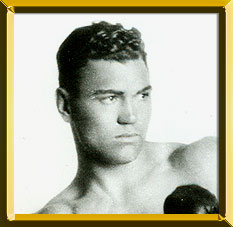
Jack Dempsey was one of America's first great sports heroes. His savage style captivated the public and made him as popular a figure as Babe Ruth or Red Grange.
In the ring, Dempsey was equipped with a two-fisted attack. He boxed out of a low crouch, bobbing, weaving and bombing. He continually stalked the man in front of him and was an unrelenting and remorseless warrior.
His power was so prodigious that he once scored knockouts in 14 and 18 seconds. In his 78-bout career, Dempsey compiled 49 knockouts, with 25 of them in the first round.
Born William Harrison Dempsey in Manassa Colorado, Dempsey was one of 11 children. He left home at the age of 16 and traveled the west on freight trains with hobos, settling occasionally in mining towns. It was during that period of his life that Dempsey learned how to fight as a means of survival. Dempsey's career turned around when he met manager Jack "Doc" Kearns. Under Kearns, Dempsey knocked out Fireman Jim Flynn, Fred Fulton, former light heavyweight titlist Battling Levinsky and Gunboat Smith.
On July 4, 1919, Dempsey challenged heavyweight champion Jess Willard at an outdoor arena in Toledo, Ohio. Temperatures in the ring reached 100 degrees that day. Willard was beaten to the canvas seven times in the first round. There was nothing artistic about Dempsey's attack. It was pure rage. The fight ended when Willard failed to answer the bell for the fourth round.
Dempsey made easy title defenses against Billy Miske, Bill Brennan, Georges Carpentier Tommy Gibbons. The Carpentier fight generated boxing's first million-dollar gate.
On September 14, 1923, another chapter was added to the Dempsey legend. He faced Argentina's Luis Angel Firpo at the Polo Grounds in New York. Known as the "Wild Bull of the Pampas," Firpo was dropped seven times in the first round. But before the stanza ended, the challenger sent Dempsey through the ropes with a single right hand, silencing the 80,000 in attendance. Dempsey made it back into the ring and beat the 10-count. The fight ended 57 seconds into the second round with Dempsey a knockout winner.
Dempsey was inactive in 1924 and '25 and put his title on the line against Gene Tunney in 1926. At 31, Dempsey fell behind on points and was never able to change the momentum.
In July of 1927, Dempsey knocked out future champion Jack Sharkey in the seventh-round (the knockout blow was setup by a punch that landed low). Two months later, Dempsey met Tunney at Chicago's Soldier Field. The fight drew a crowd of 104,943, generating a gate of $2,658,660. Tunney was again outboxing Dempsey when he was dropped in the seventh round.
Before the fight, it was agreed upon that after a knockdown, the fighter scoring the knockdown would go to a neutral corner. But when Tunney hit the canvas, Dempsey hovered over the fallen champ, ignoring the referee's order that he retreat a neutral corner. By the time Dempsey was ushered across the ring and the referee began his count, it is estimated that Tunney had 14 seconds to recover. Tunney got up and won the fight by decision, but the long-count controversy would remain etched in boxing history.
Dempsey retired after the Tunney fight but remained a popular figure until his death in 1983.
Born: June 24, 1895
Died: May 31, 1983
Bouts: 81
Won: 61
Lost: 6
Drew: 8
ND: 6
KOs: 50
Induction: 1990
Jack Dempsey
